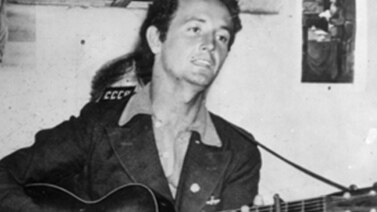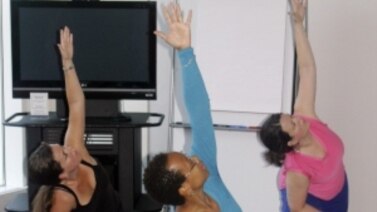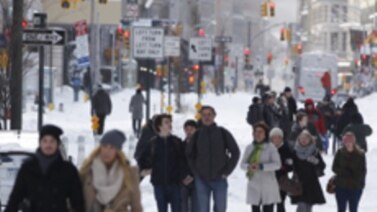VOICE ONE:
Welcome to THIS IS AMERICA in VOA Special English. I'm Faith Lapidus.
VOICE TWO:
And I'm Steve Ember. This week on our program, we have the last of our four-part series on living with a disability in America. Last month we talked about assistive technology. Before that, it was education and employment. Today, in Part Four, our subject is sports and recreation for people with disabilities.
(MUSIC)
VOICE ONE:
In August of two thousand eight, athletes from the United States and around the world will compete in the Beijing Olympics. But did you know that in September of next year, disabled athletes will compete in the Paralympic Games in Beijing?
The Olympics and the Paralympics are separate movements. But they have always been held in the same year. And since nineteen eighty-eight, they have also been held in the same city. The International Olympic Committee and the International Paralympic Committee signed an agreement in two thousand one to secure this connection.
The next winter games will take place in Vancouver, Canada, in two thousand ten.
VOICE TWO:
The Paralympic Games grew out of a sports competition held in nineteen forty-eight in England. A doctor named Ludwig Guttmann organized it for men who suffered spinal cord injuries in World War Two. Four years later, it became an international event as competitors from the Netherlands took part.
Then, in nineteen sixty, the first Paralympics were held in Rome. Four hundred athletes from twenty-three countries competed. By two thousand four, the Paralympic Games in Athens had almost four thousand athletes from one hundred thirty-six countries.
Athletes may have physical or mental limitations; they may be blind or in wheelchairs. Yet sometimes they perform better than athletes without disabilities.
VOICE ONE:
In nineteen sixty-eight, Eunice Kennedy Shriver, the sister of former President John F. Kennedy, started the Special Olympics. These games are just for children and adults with mental limitations. The Special Olympics Web site says programs currently serve more than two million people in one hundred sixty countries.
This past November, in Mumbai, India, teams competed in the First Special Olympics International Cricket Cup. In addition to India, there were men's teams from Afghanistan, Australia, Bangladesh, Nepal, Pakistan, Sri Lanka and the West Indies. There were also women's cricket teams from India and Pakistan.
(MUSIC)
VOICE TWO:
There are many organizations in the United States that help people with disabilities play sports.
Wheelchair tennis is a popular sport. So is basketball. In fact, there are more than one hundred professional teams playing wheelchair basketball.
Special wheelchairs for athletes are lightweight and designed for quick moves. For people who want to go really fast in their chairs, there is a Power Wheelchair Racing Association.
VOICE ONE:
In the state of Utah there is a place called the National Ability Center. It teaches all kinds of sports to people with all kinds of physical and mental disabilities. It even gives friends and family members a chance to try a sport as if they were disabled.
A reporter from the Washington Post wanted to know what it would be like for a blind person to use a climbing wall. So, protected by a safety line, the newspaper reporter closed his eyes and started to feel for places to put his hands and feet. Trainers on the ground urged him on: "Take your time. You can do it." Finally he reached the top.
VOICE TWO:
At the National Ability Center people can learn to ride horses and mountain bikes. They can try winter mountain sports, and learn scuba diving and other water activities.
The center also prepares athletes for the Paralympics.
(MUSIC)
VOICE ONE:
These days, the first place many people go when they want to travel is the Internet. On the Web they can get information about hotels, transportation and services like tour companies. The Internet can also help travelers find special services for the disabled. For example, there are groups that help young people with disabilities travel to different countries.
Susan Sygall leads an organization called Mobility International USA. She has traveled to more than twenty-five countries to talk about the rights of people with disabilities. She herself uses a wheelchair. People with disabilities are all members of a global family, she says. She says working together across borders is the most powerful way of making changes.
VOICE TWO:
Another American organization is called Wilderness Inquiry. This group leads camping trips to places in Kenya, Norway, Australia and the American state of Alaska. The man who started Wilderness Inquiry, Greg Lais [pronounced lays] likes people with and without disabilities to travel together.
One family came on a trip with two sons. One boy was in a wheelchair because of cerebral palsy. Greg Lais says the other children on the camping trip accepted the boy and included him in games. "People are accepted for who they are," he says.
(MUSIC)
VOICE ONE:
Another outdoor sport that may be available to people with disabilities is hunting. Several national wildlife refuges in the United States organize special hunts. One of them is a refuge in South Carolina where Bobby Harrell goes deer hunting every year with other people with disabilities.
Bobby Harrell became disabled in nineteen ninety-three. He enjoys, in his words, "seeing people get back into doing things that they used to do but didn't think they could."
In some places there are trails that can be used by hunters in wheelchairs. Some disabled hunters use specially designed guns that are fired by blowing air through a tube.
(MUSIC)
VOICE TWO:
Today there are more and more choices of entertainment for people with disabilities.
Theaters may offer wireless earphones to make the sound louder for people with limited hearing. Some provide a visual interpreter to describe a performance or a play for a person who is blind or has limited sight.
And some movie theaters offer a new device called MoPix, for Motion Picture Access. For a person unable to hear the movie, it shows the words the actors are saying. For a person unable to see the movie, it provides a spoken description of what is happening.
(MUSIC)
VOICE ONE:
For disabled people interested in yoga, there are special stretching exercises. Matthew Sanford knows about these. He has been in a wheelchair ever since a car accident when he lost the ability to move his legs. He was thirteen years old at the time. That was almost thirty years ago.
Matthew Sanford says he has had two lives: one before he was thirteen and the other after. He had to learn to live with a new reality. For many years, he was told to build up the strength in his arms and forget about his legs.
But he says yoga enabled him to reconnect with the thirteen-year-old boy who loved his body. He says the exercises and special breathing of yoga let him connect his body and mind again.
Now Matthew Sanford teaches yoga at his studio in the state of Minnesota. He also travels to talk to people about living with a disability. He says feeling connected to our body is a powerful part of living -- whether we have a disability or not.
(MUSIC)
VOICE TWO:
The earlier reports in our series on living with a disability in America can be found at voaspecialenglish.com. Our four-part series was written by Karen Leggett and produced by Caty Weaver. I'm Steve Ember.
VOICE ONE:
And I'm Faith Lapidus. Be sure to join us again next week for THIS IS AMERICA in VOA Special English.




